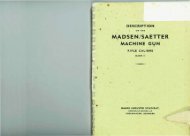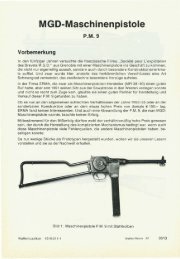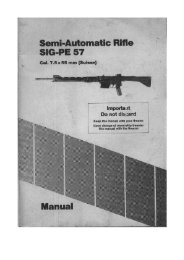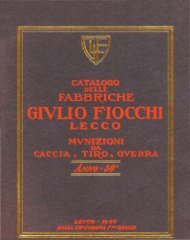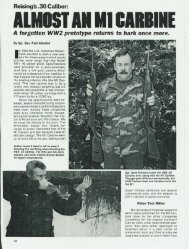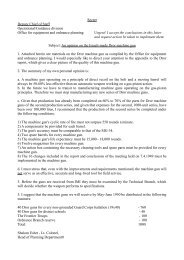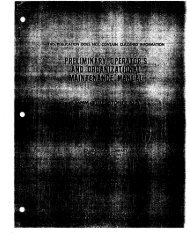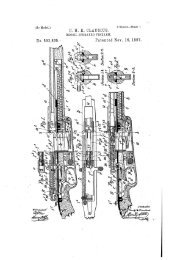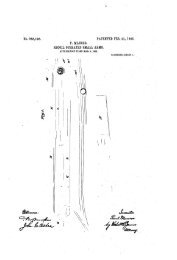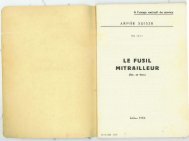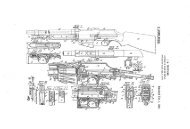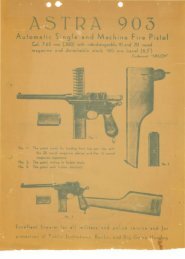TM 9-1005-208-35 M1918A2 BAR.pdf - Forgotten Weapons
TM 9-1005-208-35 M1918A2 BAR.pdf - Forgotten Weapons
TM 9-1005-208-35 M1918A2 BAR.pdf - Forgotten Weapons
You also want an ePaper? Increase the reach of your titles
YUMPU automatically turns print PDFs into web optimized ePapers that Google loves.
2-5. General<br />
This section provides the necessary instructions<br />
on the general maintenance procedures to follow. The<br />
methods are to be carefully observed during repair<br />
operations. Operator and organizational maintenance<br />
instructions are contained in <strong>TM</strong> 9<strong>1005</strong>-<strong>208</strong>-12. This<br />
section includes the disassembly and assembly<br />
procedures, replacement of parts, use of tools, cleaning,<br />
finished surfaces, removal of burs, and lubrication.<br />
2-6. General Repair Methods<br />
a. Disassembly and Assembly Procedures.<br />
(1) In disassembling a unit, remove the<br />
major subassemblies and assemblies whenever<br />
possible. Subassemblies may be disassembled, as<br />
necessary, into individual parts.<br />
(2) During assembly, subassemblies will<br />
be assembled first, then installed to form a complete<br />
unit. Lubricate sliding surfaces before assembling.<br />
(3) Complete disassembly of a unit is not<br />
always necessary in order to make a required repair or<br />
replacement. Good judgment should be exercised to<br />
keep disassembly and assembly operations to a<br />
minimum.<br />
b. Replacement, of Parts.<br />
(1) Parts or assemblies that cannot be<br />
repaired or reclaimed to the standards set forth, will be<br />
replaced. Nonrepairable assemblies may be<br />
disassembled and the serviceable parts returned to<br />
stock.<br />
(2) When assembling a group or assembly<br />
replace worn or damaged pins and screws.<br />
(3) All springs will be replaced if broken,<br />
kinked, cracked, or have weak tension.<br />
(4) If a required new part is not available,<br />
reconditioning of the old part is permitted. Parts will be<br />
inspected carefully after reconditioning to determine their<br />
serviceability.<br />
c. Use of Tools.<br />
(1) Care must be exercised to use tools<br />
that fit and are suitable for the task to be performed in<br />
order to avoid unnecessary mutilation of parts and/or<br />
damage to tools.<br />
(2) Special tools are provided for the<br />
maintenance of the materiel and are listed in Appendix<br />
B. These tools will be used only for the purpose for<br />
which they are intended.<br />
(3) Keep tools clean and work with clean<br />
parts. Normal rules of good housekeeping will be<br />
observed.<br />
2-7. Cleaning<br />
a. As assemblies are removed and<br />
Section IV. GENERAL MAINTENANCE<br />
6<br />
<strong>TM</strong> 9-<strong>1005</strong>-<strong>208</strong>-<strong>35</strong><br />
disassembled, the metal parts will be cleaned thoroughly<br />
of all grease, oil, and dirt using dry cleaning solvent (SD .<br />
Parts will be wiped dry with clean cloth, then coated with<br />
a light coat of general purpose lubricating oil (PL<br />
special).<br />
b. Remove rust with a cloth moistened with dry<br />
cleaning solvent (SD). If this does not suffice, use<br />
crocus cloth or fine abrasive cloth. Make certain not to<br />
scratch or alter finished surfaces. Remove all dirt and<br />
abrasives; re-oil surfaces before assembling parts.<br />
c. The bore will be cleaned thoroughly with<br />
cleaning brush 5564174 (8, fig B-11), saturated with rifle<br />
bore cleaner (RBC), then swabbed with cleaning<br />
patches. Make certain no traces of burned powder or<br />
foreign substances are left in the bore. Apply a light coat<br />
of general purpose lubricating oil (PL special).<br />
d. Clean chamber with cleaning brush<br />
6528362 17, fig.B-1 I )using rifle bore cleaner, (RBC).<br />
Wipe dry with a clean cloth, then apply a light coat of<br />
general purpose lubricating oil (PL special).<br />
e. Clean bore of gas cylinder tube using M6<br />
cleaning brush 6108828 saturated with rifle bore cleaner<br />
(RBC). Wipe dry with clean cloth then apply a light coat<br />
of general purpose lubricating oil (PL special).<br />
f. Clean gas cylinder using reamer assembly<br />
7268211. Refer to <strong>TM</strong> 9-<strong>1005</strong>-<strong>208</strong>-12.<br />
g. Clean fore end and stock assembly of<br />
grease, oil, and dirt, using a clean cloth.<br />
2-8. Finished Surfaces<br />
All treated surfaces will be refinished to match<br />
the appearance of new parts.<br />
2-9. Removal of Burs from Threads, Screwheads,<br />
and Working Surfaces<br />
During the entire life of the weapon, polishing<br />
and stoning are necessary to relieve friction and to<br />
remove burs set up by firing. Burs on screws, threads,<br />
and like surfaces will be removed with a fine file. Burs or<br />
rough edges on working surfaces will be removed with a<br />
fine sharpening stone.<br />
Caution. Care will be observed to stone or file<br />
evenly and lightly and not to remove more metal than<br />
necessary to maintain correct contour of the surfaces.<br />
Parts or assemblies will never be altered in any way as to<br />
affect functioning or interchangeability of parts.<br />
2-10. Lubrication<br />
a. Make certain all metal parts are cleaned<br />
and dried thoroughly in accordance with instructions as<br />
prescribed in paragraph 3-3.<br />
b. All metal parts will be lubricated by applying<br />
a light coat of general purpose lubricating oil (PL<br />
special). Lubricants are listed in <strong>TM</strong> 9-<strong>1005</strong>-<strong>208</strong>12.




